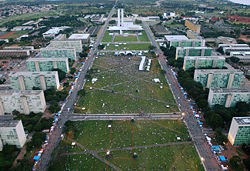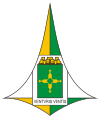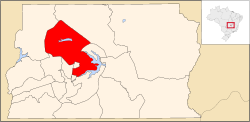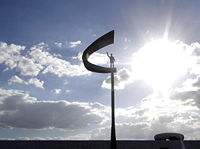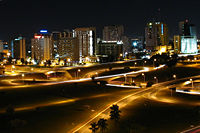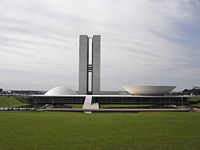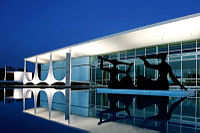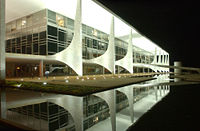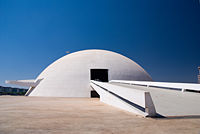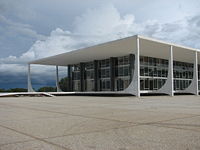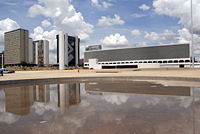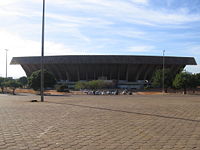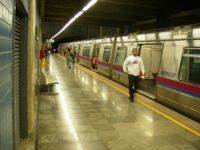Brasília
2008/9 Schools Wikipedia Selection. Related subjects: Central and South America; Cities
| Brasília | |||
| Brasília | |||
|
|||
| Nickname(s): Capital Federal, BSB | |||
| Motto: "Venturis ventis" (Latin) "To the coming winds" |
|||
| Location of Brasília | |||
| Coordinates: | |||
|---|---|---|---|
| Country | |||
| Region | Central-West | ||
| State | |||
| Founded | April 21, 1960 | ||
| Government | |||
| - Governor | José Roberto Arruda ( Democrats) | ||
| Area | |||
| - Total | 5,802 km² (2,204,2 sq mi) | ||
| Elevation | 1,172 m (3,845 ft) | ||
| Population (2008) | |||
| - Total | 2,529,580 | ||
| - Density | 435,98/km² (1,129,17/sq mi) | ||
| Time zone | UTC ( UTC-3) | ||
| Area code(s) | 61 | ||
| HDI (2000) | 0.936 – high | ||
| Website: Brasília, Federal District | |||
Brasília (IPA: [bɾaˈziliɐ]) is the capital of Brazil. It is coterminous with the Distrito Federal (Federal District) and borders the states of Goiás and Minas Gerais. The city and the district are located in the Central-West region of the country, along a plateau known as Planalto Central. It has a population of about 2,455,903 as of the 2007 IBGE census, making it the fourth largest city in Brazil. It is listed as a World Heritage Site by UNESCO.
As the national capital, Brasília is the seat of all three branches of the Brazilian government. The city also hosts the headquarters of many Brazilian companies such as the Bank of Brazil, Caixa Econômica Federal and Brasil Telecom. The city is a world reference for urban planning. The locating of residential buildings around expansive urban areas, of building the city around large avenues and dividing it into sectors, has sparked a debate and reflection on life in big cities in the 20th century. The city’s planned design included specific areas for almost everything, including accommodation – Hotel Sectors North and South. However, new areas are now being developed as locations for hotels, such as the Hotels and Tourism Sector North, located on the shores of Lake Paranoá. Brasília offers modern and comfortable hotels, including hotels managed by international chains; but it also offers cozy and modest inns, B&Bs and hostels.
The city was planned and developed in 1956 with Lúcio Costa as the principal urban planner and Oscar Niemeyer as the principal architect. In 1960, it formally became Brazil's national capital. When seen from above, the city's shape resembles an airplane or a butterfly. The city is commonly referred to as Capital Federal, Capital da Esperança (which translates to Capital of Hope), or simply BSB. People from the city of Brasília are known as brasilienses or candangos.
The Brasília International Airport is a major hub for the rest of the country, connecting the capital to all major Brazilian cities and many international destinations. It is the third most important airport of Brazil, considering passengers and airplane traffic.
The city is home of University of Brasília.
Background
Brasília was built to be Brazil's new capital city. The idea was to transfer the federal capital of Brazil from the coast to the midwestern interior of the country. Previously the capital of Brazil was situated in Rio de Janeiro and before that in Salvador. By relocating the capital city to the interior, the government intended to help populate that area of the country. People from all over the country were hired to build the city, especially those from the Northeast region of Brazil. These workers would be known as candangos. Brasília is known, internationally, for having applied the principles established in the Athens Charter of 1933.
History
President Juscelino Kubitschek ordered the construction of Brasília, fulfilling an article of the country's constitution stating that the capital should be moved from Rio de Janeiro to a place close to the centre of the country. Lúcio Costa won a contest and was the main urban planner. Oscar Niemeyer, a close friend of Lúcio, was the chief architect of most public buildings and Roberto Burle Marx was the landscape designer. Brasília was built in 41 months, from 1956 to April 21, 1960, when it was officially inaugurated.
From 1763 to 1960, Rio de Janeiro was the capital of Brazil. At this time, resources tended to be centred in Brazil's southeast region near Rio de Janeiro. Brasília’s geographical central location made for a more regionally neutral federal capital.
The concept of locating the capital in the centre of Brazil was first made in 1891 but was not defined until 1922.
According to a legend, Italian saint Don Bosco in 1883 had a prophetic dream in which he described a futuristic city that roughly fitted Brasília's location. Today, in Brasília, there are many references to this educator who founded the Salesian order. One of the main churches in the city bears his name.
Brasília is the result of a modern urban project designed by Lúcio Costa. When seen from above, the city’s pilot plan resembles the shape of an airplane – many prefer to refer to it as a bird with open wings –, although the architect’s original urban concept pointed to the shape of a cross, to symbolize possession.
The city also hosts a varied assortment of art works from artists like Bruno Giorgi, Alfredo Ceschiatti, Athos Bulcão, Marianne Peretti, Alfredo Volpi, Di Cavalcanti, Victor Brecheret and Burle Marx, whose works have been integrated into the city’s architecture, making it a unique landscape.
As a venue for political events, music performances and movie festivals, Brasília is a cosmopolitan city, with around 90 embassies, a wide range of restaurants and complete infrastructure ready to host any kind of event. Not surprisingly, the city stands out as an important business tourism destination, which is an important part of the local economy, with dozens of hotels spread around the national capital.
Climate
The national capital’s climate is tropical savanna according to Köppen's classification, with seasons being defined according to the degree of humidity of the air: one season is dry and colder, while the other one is humid and warm. The average temperature is 20.5°C (69°F) September has the highest average maximum temperature, 28°C (82.9°F), and July has the lowest average maximum temperature, 25°C (77.2°F). The lowest minimum average temperature is in July, at 13°C (55.2°F) and the highest minimum average temperatures are during November and December, 18°C (63.5°F). Those, however, are monthly averages, temperatures sometimes fall outside of this range. The absolute minimum temperature recorded was 1.6°C (34°F) and the absolute maximum was 34.7°C (94.46°F).
| Weather averages for Brasília | |||||||||||||
|---|---|---|---|---|---|---|---|---|---|---|---|---|---|
| Month | Jan | Feb | Mar | Apr | May | Jun | Jul | Aug | Sep | Oct | Nov | Dec | |
| Average high °C (°F) | 26.9 (80) | 26.7 (80) | 27.1 (81) | 26.6 (80) | 25.7 (78) | 25.2 (77) | 25.1 (77) | 27.3 (81) | 28.3 (83) | 27.5 (82) | 26.6 (80) | 26.2 (79) | |
| Average low °C (°F) | 17.4 (63) | 17.4 (63) | 17.5 (64) | 16.8 (62) | 15 (59) | 13.3 (56) | 12.9 (55) | 14.6 (58) | 16.0 (61) | 17.4 (63) | 17.5 (64) | 17.5 (64) | |
| Precipitation mm (inches) | 241.4 (9.5) | 214.7 (8.45) | 188.9 (7.44) | 123.8 (4.87) | 39.3 (1.55) | 8.8 (0.35) | 11.8 (0.46) | 12.8 (0.5) | 51.9 (2.04) | 172.1 (6.78) | 238 (9.37) | 248.6 (9.79) | |
| Source: worldweather.org 2007-10-19 | |||||||||||||
World Heritage Site
| Brasília* | |
|---|---|
| UNESCO World Heritage Site | |
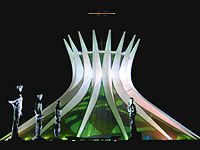 Brasília's Cathedral-Basilica of Our Lady Aparecida by Oscar Niemeyer |
|
| State Party | |
| Type | Cultural |
| Criteria | i, iv |
| Reference | 445 |
| Region** | South America |
| Inscription history | |
| Inscription | 1987 (11th Session) |
| * Name as inscribed on World Heritage List. ** Region as classified by UNESCO. |
|
The Brazilian capital is the only city in the world built in the 20th century to be awarded (in 1987) the status of Historical and Cultural Heritage of Humanity by UNESCO, a specialized agency of the United Nations.
Economy
Brasília's economy is dominated by
(a) services (91% of local GDP, according to the IBGE):
- government (the public sector is by far the largest employer, accounting for around 40% of the city jobs. Government jobs include all levels, from the federal police to diplomacy, from the transportation bureau to the armed forces);
- communications ( Brasil Telecom's HQ, public and private TV stations including regional offices of Globo, SBT, Rede Bandeirantes, Rede Record, RedeTV! and the main offices of TV câmara, TV Senado and TV Justiça),
- banking and finance (headquarters of the Banco do Brasil, the Caixa Econômica Federal, the Brazilian Central Bank, the Banco Rural and the Banco de Brasília, among others),
- entertainment,
- information technology ( Politec, Poliedro, CTIS, among others), and
- legal services.
(b) industries in the city include:
- Construction (Paulo Octavio, Via Construções, and Irmãos Gravia among others),
- Food processing (Perdigão, Sadia),
- Furniture Making,
- recycling (Novo Rio, Rexam, Latasa and others),
- pharmaceuticals (União Química), and
- printing and publishing.
The main agricultural products produced in the city are coffee, guavas, strawberries, oranges, lemons, papayas, soy beans and mangoes. It has over 110,000 cows and it exports wood products worldwide.
Federal District, where Brasilia is located, GDP is about US$69,844 billion, according to the IBGE. Its share of Brazilian GDP is 3.8%
Federal District has the largest per capita income of Brazil (about US$ 27,610 per person, according to the IBGE). Brasília per capita income is believed to be much higher.
Brasília hosts a wide range of services such as hospitals, schools, fitness clubs, clubs, colleges, restaurants, cafes, etc. These services are, however, unevenly distributed.
Accommodation
The city’s planned design included specific areas for almost everything, including accommodation – Hotels Sectors North and South. New hotel facilities area being developed elsewhere, such as the hotels and tourism Sector North, located on the shores of Lake Paranoá. Brasilia offers modern and comfortable hotels, including hotels managed by international chains; but it also offers cozy and modest inns, pensions and hostels.
Brasilia receives visitors from the whole of Brazil and the world, it offers a good range of restaurants with great diversity of food; from simple small restaurants, serving the authentic food of Central-Western areas of Brazil, to selected bistros.
Culture
Traditional parties take place throughout the year. In June, there are large festivals celebrating Catholic saints, such as Saint Anthony and Saint Peter, that are called " festas juninas", or June festival. Throughout the year there are local, national and international events spread through the city. Christmas is widely celebrated, and New Years Eve usually hosts major events.
Historic sites and museums
Monumental Axis
At the end of the Monumental Axis lies the Ministries Esplanade, an open area in downtown Brasília. The rectangular lawn area is surrounded by two eight-lane wide avenues where many important government buildings, monuments and memorials are located. This is the main body of the "airplane" shape of the city, as planned by Lúcio Costa. It resembles the National Mall, in Washington, D.C..
National Congress
Brazil's bicameral National Congress consists of the Senate of Brazil (the upper house) and the Chamber of Deputies of Brazil (the lower house). Since the 1960s, the National Congress has its seat in Brasília. As with most of the official buildings in the city, it was designed by Oscar Niemeyer following the style of modern Brazilian architecture. The semisphere to the left is the seat of the Senate, and the semisphere to the right is the seat of the Chamber of the Deputies. Between them there are two towers of offices. The Congress also occupies other surrounding buildings, some of them interconnected by a tunnel.
The building is located in the middle of the Monumental axis, the main avenue of the capital. In front of it there is a large lawn and a reflecting pool. The building faces the Praça dos Três Poderes, where the Palácio do Planalto and the Supremo Tribunal Federal are located.
It is interesting to note that this building also served as a model for the Empire State Plaza in Albany NY, USA.
Palácio da Alvorada
The Palácio da Alvorada is the official residence of the President of Brazil. The palace was designed, along with the rest of the city of Brasília, by Oscar Niemeyer and inaugurated in 1958.
One of the first structures built in the republic's new capital city, the "Alvorada" lies on a peninsula at the margins of Lake Paranoá. The principles of simplicity and modernity, that in the past characterized the great works of architecture, motivated Niemeyer. The viewer has an impression of looking at a glass box, softly landed on the ground with the support of thin external columns.
The building has an area of 7,000 m2 and three floors: basement, landing and second floor. The auditorium, kitchen, laundry, medical centre, and the administration are at basement level. The rooms used by the presidency for official receptions are on the landing. There are four suites, two apartments and other private rooms on the second floor which is the residential part of the palace.
The building also has a library, a heated Olympic-sized swimming pool, a music room, two dining rooms and various meeting rooms. There is a chapel and heliport in adjacent buildings .
Palácio do Planalto
The Palácio do Planalto is the official workplace of the President of Brazil. It is located at the Praça dos Três Poderes in Brasília. As the seat of government, the term "o Planalto" is often used as a metonym for the executive branch of the government.
The main working office of the President of the Republic is in the Palácio do Planalto. The President and his family, however, do not live in it; the official residence of the President is the Palácio da Alvorada. Besides the President, senior advisors also have offices in the "Planalto", including the Vice-President of Brazil and the Chief of Staff; the other Ministries are laid along the Esplanada dos Ministérios.
The architect of the Palácio do Planalto was Oscar Niemeyer, the "creator" of most of the important buildings in the new capital of Brasília. The idea was to project an image of simplicity and modernity using fine lines and waves to compose the columns and exterior structures.
The Palace is four stories high, and has an area of 36,000 m². Four other adjacent buildings are also part of the complex.
Cultural Complex of the Republic
The Cultural Complex of the Republic ("Complexo Cultural da República" in Portuguese) is a cultural centre located along the Monumental Axis, in the city of Brasília. It is formed by the National Library of Brasília and the National Museum of the Republic'.
The National Library of Brasília (Biblioteca Nacional de Brasília in Portuguese) occupies an area of 14,000 m², consisting of reading and study rooms, auditorium and a collection of over 300,000 items.
The National Museum of the Republic (Museu Nacional da República in Portuguese) consists of a 14,500 m² exhibit area, two 780-seat auditoriums, and a laboratory. The space is mainly used to display temporary art exhibits.
Paranoá Lake
Paranoá Lake is a giant artificial lake built in order to increase the amount of water available to the region. It holds the second largest marina in Brazil, and is home to the capital's wakeboard and windsurf practitioners.
Juscelino Kubitschek bridge
The Juscelino Kubitschek bridge, also known as the 'President JK Bridge' or the 'JK Bridge', crosses Lake Paranoá in Brasília. It is named after Juscelino Kubitschek de Oliveira, former president of Brazil. It was designed by architect Alexandre Chan and structural engineer Mário Vila Verde. Chan won the Gustav Lindenthal Medal for this project at the 2003 International Bridge Conference in Pittsburgh due to "...outstanding achievement demonstrating harmony with the environment, aesthetic merit and successful community participation".
It consists of three 60 m (200 ft) tall asymmetrical steel arches that crisscross diagonally. With a length of 1,200 m (0.75 miles), it was completed in 2002 at a cost of US$56.8 million. The bridge has a pedestrian walkway and is accessible to bicyclists and skaters.
Praça dos Três Poderes
Praça dos Três Poderes (Portuguese for Square of the Three Powers) is a plaza in Brasília. The name is derived from the encounter of the three federal branches around the plaza: the Executive, represented by the Palácio do Planalto (presidential office); the Legislative, represented by the Congresso Nacional (National Congress); and the Judicial branch, represented by the Supremo Tribunal Federal (Supreme Federal Court).
It is a tourist attraction in Brasília. It was designed by Lúcio Costa and Oscar Niemeyer as a place where the three branches of the Republic would meet harmonically.
Cathedral of Brasília
The Cathedral of Brasília in the capital of the Federative Republic of Brazil, is an expression of the architect Oscar Niemeyer. This concrete-framed hyperboloid structure, seems with its glass roof to be reaching up, open, to heaven. On 31 May 1970, the Cathedral’s structure was finished, and only the 70 m diameter of the circular area were visible. Niemeyer's project of Cathedral of Brasília is based in the hyperboloid of revolution which sections are asymmetric. The hyperboloid structure itself is a result of 16 identical assembled concrete columns. These columns, having hyperbolic section and weighing 90 t, represent two hands moving upwards to heaven. The Cathedral was dedicated on 31 May 1970.
Demographics
In the 1960 census there were almost 140,000 residents in the new Federal District; by 1970 this figure had grown to more than 537,000. In 2000 the population of the Brazilian Federal District was more than two million. Brasília has one of the highest growth rates in Brazil. Its population increases by 2.82% each year. Brasília's inhabitants include a foreign population of mostly embassies workers as well as large numbers of Brazilian migrants.
The Human Development Index in the city is at 0.936 (developed nation level), and the illiteracy rate is around 4.35%.
Education
Portuguese is the official national language, and thus the primary language taught in schools. But English and Spanish are part of the official high school curriculum. There are some international schools that provide conventional education in foreign languages, mainly English, such as the American School of Brasilia ( http://www.eabdf.br/)
Educational institutions
- Universidade de Brasília - University of Brasília - (UnB)
- Universidade Católica de Brasília - Catholic University of Brasília - (UCB)
- Instituto Científico de Ensino Superior e Pesquisa (UNICESP)
- Centro Universitário de Brasília (UniCEUB)
- Centro Universitário do Distrito Federal (UniDF)
- Centro Universitário Euroamericano (UNIEURO)
- Instituto de Educação Superior de Brasília (IESB)
- União Pioneira da Integração Social (UPIS)
- Universidade Paulista (UniP)
Sports
Soccer
Brasília is home to two major football teams. None of them have been successful in the first division, due to the dominance of the bigger clubs from Rio de Janeiro and São Paulo:
- Brasiliense Futebol Clube from Taguatinga
- Sociedade Esportiva do Gama
The main football stadiums are the Estádio Mané Garrincha and the Serejão.
Brasília is one of the 18 remaining candidates to host games of the 2014 FIFA World Cup, for which Brazil is the host. The rebuilding of Garrincha Stadium is planned.
Transportation
International Airport
Brasília International Airport - President Juscelino Kubitschek (BSB/SBBR) serves the metropolitan area with major domestic and international flights. It is the third busiest Brazilian airport based on passengers and aircraft movements. Because of its strategic location it is a civil aviation hub for the rest of the country. This makes for a large number of takeoffs and landings and it is not unusual for flights to be delayed in the holding pattern before landing. Following the airport's master plan, Infraero built a second runway, which was finished in 2006. In 2007, the airport handled 11,119,872 passengers. The main building's third floor, with 12 thousand square meters, has a panoramic deck, a food court, shops, four movie theaters with total capacity of 500 people, and space for exhibitions. There are 136 shop spaces at Brasília Airport.
Metro
Brasília Metro is Brasília's underground metro system. The subway system has 16 stations on two lines - the Orange and Green lines, distributed along a total network of 75 km, covering most of the metropolitan area. Both lines begin at the Central Station and run parallel until the Águas Claras Station.
Famous places nearby
Nearby attractions include:
- Chapada dos Veadeiros - A National Park with plenty of cerrado wildlife and surrounded by several spectacular waterfalls.
- Itiquira Falls - this beautiful 168 m-high waterfall is little more than 100 km from Brasília and is in the municipality of Formosa, Goiás
- Caldas Novas - The biggest natural hot springs resort of the world. Located about 360 km (225mi) southeast of the city in the state of Goiás.
- Pirenopolis - The city, located 150Km from Brasilia, is well-known for its waterfalls and colonial architecture, and a popular festival involving mounted horses called Festa do Divino Espírito Santo which takes place 45 days after Easter. Its nightlife is very popular, and a Jazz Festival takes place in May.
Notable people in Brasília
Sister cities
List of sister cities, designated by Sister Cities International:
